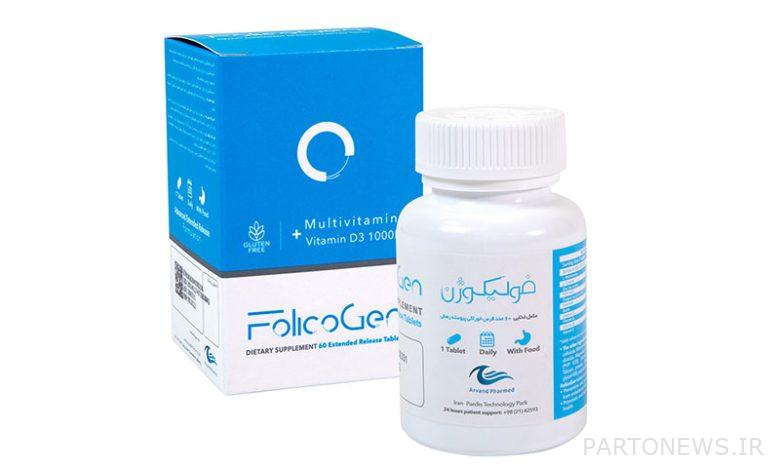Hair loss and its causes

Hair loss is a fairly common occurrence that may be temporary or permanent. Hair loss occurs gradually with age in both men and women, but is usually more pronounced in men. The medical term for hair loss is alopecia. The most common form of hair loss is called “androgenetic alopecia” and hormonal and genetic changes are involved in the occurrence of this type of hair loss. Other types of hair loss include alopecia areata (an autoimmune disease in which hair loss is patchy and usually regrows) and telogen effluvium (rapid hair loss that usually occurs after childbirth, fever, or sudden weight loss) (1). .
On average, there are 100,000 hairs on the head. The American Academy of Dermatology considers it normal to lose 50-100 hairs per day. Since new hair is growing at the same time, this amount of hair loss is usually not noticeable. Hair loss occurs when new hair does not replace the shed hair (2).
cause of hair loss
Hair loss is usually associated with one or more of the following factors:
- family history (inheritance)
The most common cause of hair loss is aging. Androgenetic alopecia, called male pattern baldness and female pattern baldness, usually occurs gradually and with predictable patterns.
- Hormonal changes and disease
Various conditions can cause permanent or temporary hair loss, including hormonal changes due to pregnancy, childbirth, menopause, and various diseases, including thyroid diseases.
Hair loss can be a side effect of certain medications, such as those used for cancer, rheumatoid arthritis, depression, heart problems, gout, and high blood pressure.
Many people experience hair loss several months after a physical or emotional shock. This type of hair loss is temporary.
Hair loss is a common occurrence after severe weight loss. Restricted diet or weight loss surgery causes hair loss due to lack of nutrients (3).
- Inappropriate feeding
Nutrient deficiencies may affect hair structure and growth. Hair follicle cells are rapidly dividing. On the other hand, micronutrients are one of the main elements in the natural cycle of the hair follicle and play an important role in the cell cycle.
Using supplements containing vitamins, minerals and other nutrients prevents hair loss and thinning (4).
Introduction of follicogen supplement
Follicogen supplement contains vitamins, minerals and substances needed to prevent and treat hair loss. In the following, the role of complementary components of follicogen in the prevention and treatment of hair loss is mentioned.
Al-Metyunin
Methionine is an essential amino acid that cannot be made in the body and must be obtained through diet and supplements. This amino acid contains sulfur and improves skin elasticity, strengthens hair and nails (5).
L-cysteine
Cysteine amino acid is one of the constituents of keratin and collagen, so it maintains the strength and elasticity of hair and prevents hair loss (6).
Zink
Zinc is an essential trace element, meaning that the body cannot produce it on its own and must be supplied through the diet. Zinc deficiency may cause hair loss, which can be treated with zinc supplements. Zinc deficiency causes changes in the protein structure of hair follicles and leads to weakening and hair loss. On the other hand, due to its role in cell division, it makes the hair growth cycle longer (4).
copper
Copper is one of the main elements in the production of melanin. Melanin is the main pigment of skin and hair. Therefore, taking supplements containing this mineral is a very effective way to help protect against hair graying. By prolonging the hair cycle, copper increases its life and stimulates new hair growth (7).
biotin
Biotin is a water-soluble vitamin and one of the B vitamins. Biotin stimulates the production of keratin in hair and can increase the growth rate of follicles (4).
Selenium
Selenium is an essential mineral and plays an important role in the synthesis of many proteins, thus helping hair growth. On the other hand, due to its antioxidant properties, selenium prevents the damage of hair follicles against free radicals (4).
Folic acid
Folic acid is also a water-soluble vitamin and one of the B vitamins. This vitamin plays a significant role in cell division of hair follicles and helps hair growth. The use of supplements containing folic acid can be effective in hair loss caused by anemia and pregnancy (4).
Vitamin D
Lack of vitamin D in the body can lead to hair loss. One of the roles of vitamin D is to stimulate the division of hair follicles. If the amount of vitamin D in the body is not enough, hair growth can stop (4).
Vitamin E
Vitamin E is a strong antioxidant and improves hair growth in people suffering from hair loss by reducing oxidative stress. Vitamin E helps hair health by increasing blood flow. Also, this vitamin causes shine, increases moisture, reduces breakage and protects hair from damage (4).
Vitamin B5 and B6
These vitamins help to strengthen and nourish the hair follicle and prevent hair loss.
Follicogen supplement is used in the following cases:
- Prevention and treatment of hair loss caused by improper diet
- Prevention and treatment of hair loss caused by the use of drugs
- Prevention and treatment of hair loss caused by some diseases
- Prevention and treatment of hair loss caused by stress
- Improving the growth and health of hair, skin and nails
Each pack of Follicogen supplements contains 60 tablets. Follicogen is a continuous release tablet and its product is released over a longer period of time; Therefore, it reduces the frequency of drug use and is economical. Follicogen is taken as one pill a day with food.
Sources:
- Gupta M, Mysore V. Classifications of Patterned Hair Loss: A Review. J Cutan Aesthet Surg. 2016;9(1):3-12.
- Robbins C, Mirmirani P, Messenger A, Birch M, Youngquist R, Tamura M, et al. What women want-quantifying the perception of hair amount: an analysis of hair diameter and density changes with age in Caucasian women. British Journal of Dermatology. 2012;167(2):324-32.
- Phillips TG, Slomiany WP, Allison R. Hair Loss: Common Causes and Treatment. Am Fam Physician. 2017;96(6):371-8.
- Almohanna HM, Ahmed AA, Tsatalis JP, Tosti A. The Role of Vitamins and Minerals in Hair Loss: A Review. Dermatol Ther (Heidelb). 2019;9(1):51-70.
- Borowczyk K, Suliburska J, Jakubowski H. Demethylation of methionine and keratin damage in human hair. Amino Acids. 2018;50(5):537-46.
- Strasser B, Mlitz V, Hermann M, Tschachler E, Eckhart L. Convergent evolution of cysteine-rich proteins in feathers and hair. BMC Evolutionary Biology. 2015;15(1):82.
- Kil MS, Kim CW, Kim SS. Analysis of serum zinc and copper concentrations in hair loss. Ann Dermatol. 2013;25(4):405-9.
Please rate this article
[مجموع: ۱ میانگین: ۵]

